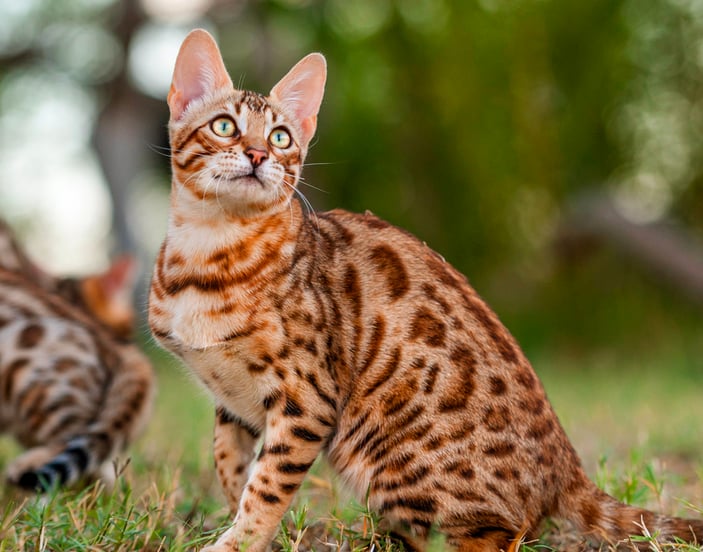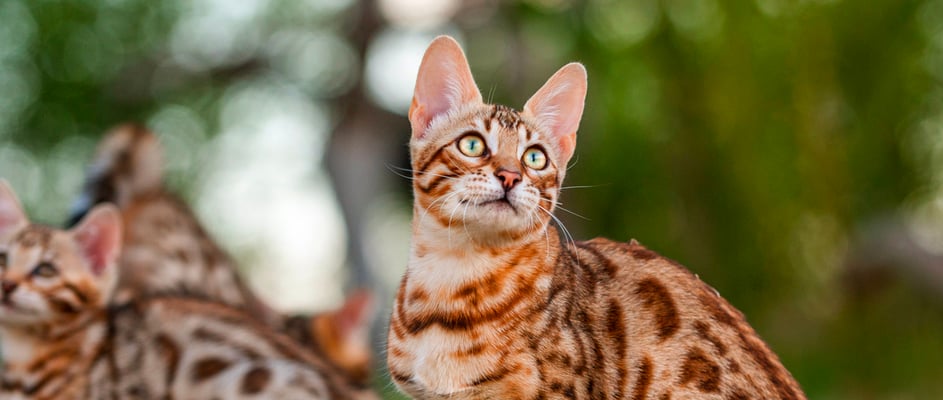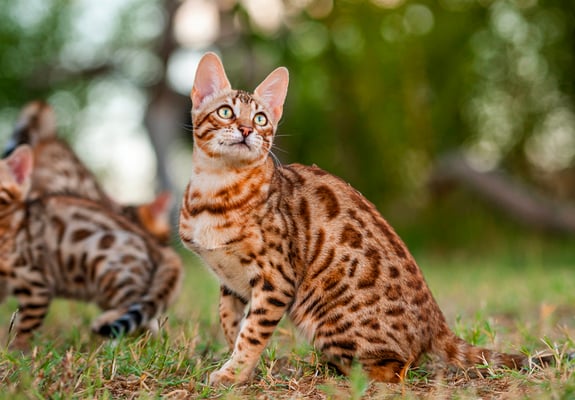The guide to owning a Bengal cat.
Looking to welcome a cat into your home but not sure where to begin? Welcome, you’re in the right place. Secure a no-obligation quote with Waggel to make sure your new friend gets the cover they deserve.
Jump to:
Stats at a glance.
The Bengal cat is a dazzling and energetic breed that springs from the union of the Asian Leopard cat and a domestic cat.
Their wild appearance and sleek coat make them look like tiny leopards roaming through your home. Yet they can be quite gentle, especially when socialised properly from a young kitten stage.
Below, we’ll explore the characteristics of the Bengal cat, along with practical tips on keeping their coats healthy, feeding them a proper diet, and making sure they fit well into your everyday life.
History of the Bengal cat.
Many cat breeds emerge from interesting experiments and careful record-keeping. But the Bengal cat breed started with a desire to blend the exotic grace of wild ancestors—namely Asian Leopard cats with domestic felines—to create a cat with a wild yet friendly nature.
Jean Mill, often credited with shaping the modern Bengal, wanted a cat with a sweet temperament that ordinary families could enjoy, despite its untamed look.
By the 1980s, Bengals gained recognition. Later, the International Cat Association granted them full championship status. Today, you can find these beautiful hybrid cats across the globe.
Because of their roots, Bengal cats are known for both agility and curiosity. They’re happy to climb tall platforms, peer into sinks, and watch running water.
Take one look at a Bengal kitten, and you’ll notice the hint of a leopard-like attitude, even if it comes packaged with plenty of domestic affection.
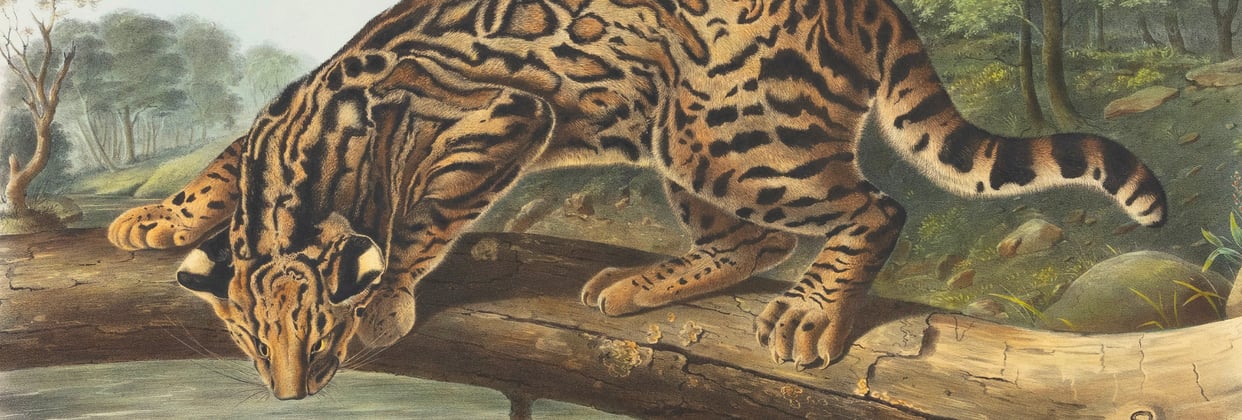

Physical characteristics.
Bengals are medium to large in size, typically weighing anywhere from 3.5 kg to 7 kg. They have a long and muscular build that’s more athletic than many other cat breeds.
Their coat is equally noteworthy. You’ll see options like spotted or marbled. The spots often form rosette shapes that echo those of actual leopards.
Some Bengals display warm brown Bengal hues, while others come in snow and silver variations. Either way, their fur can feel silky, sometimes with a unique shimmer known as “glitter.”
The head is somewhat small in proportion to the body, and the ears have a slight forward tilt. Their bright eyes often lock onto anything moving, especially that tempting piece of yarn you meant to put away.
Bengal cats are medium-large but maintain a balance of power and grace. Their tail is moderately thick, tapering at the tip.
When you see a cat so sleek yet strong, you’ll know you’re gazing at a wild-looking cat with a curious heart.
Colours and patterns.
Among Bengals, you’ll find a striking range of coat patterns. The main variations are:
Spotted or marbled: Some show bold spots; others have swirling marble patterns.
Brown Bengal: This classic style often displays a golden or copper base with darker rosettes.
Snow and silver: Lighter backgrounds, sometimes with charcoal outlines, delivering a cooler overall look.
These patterns come from mixing wild Asian Leopard cat genes with cat ancestors from domestic lines.
Because of this, you get a swirling palette of hues that stands out. Even a single litter can reveal varied patterns.
No matter the pattern, Bengals typically have coats that gleam. With proper grooming and nutrition, you may see that trademark shimmer every time they pass through a sunny window.





Temperament and personality.
Bengal cats are known for being outgoing, playful, and highly active and intelligent.
They might greet you by following you around the house or by letting loose a series of unusual chirps.
They’re often full of energy, so don’t be surprised if you find them at the top of a bookshelf.
If you’re planning to keep a Bengal in the house, consider adding cat shelves or tall trees so they can climb safely. Bengals are known to adore vantage points.
Still, they can be sweet family pets, forming close bonds with people, especially if socialised from their Bengal kitten days.
They’re curious and confident. Though they might not enjoy being cuddled 24/7, they will sit close, watch everything you do, and investigate every noise.
Bengal cats are medium to large in size, so keep an eye on fragile items around the house.
If you prefer a calm, laid-back lap cat, a Bengal might seem too spirited. But if you enjoy lively, interactive pets, you’ll probably love them.
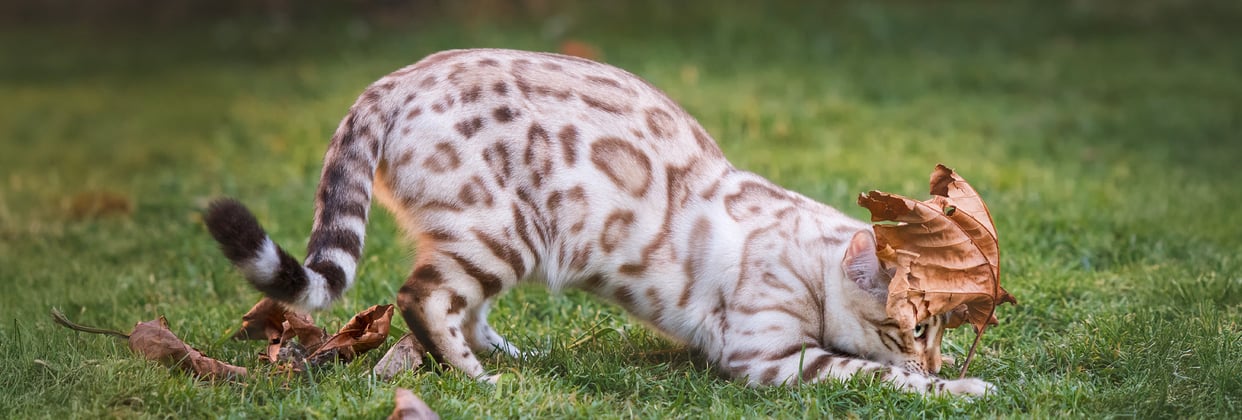

Health considerations.
In terms of overall health, Bengals tend to be robust. However, any pure breed can carry certain risks, so it’s wise to watch for issues like:
Hypertrophic cardiomyopathy (HCM): This heart condition can arise in Bengals. Reputable accredited Bengal cat breeders usually test for it which costs around £50 with treatment costs being considerably more expensive.
Progressive retinal atrophy (PRA): This rare eye problem can lead to vision changes. Regular check-ups can help catch it early. Tests for this cost around £70 and treatment also varies.
Keeping them at a healthy weight is crucial. Because diet is extremely important, focus on balanced cat food and watch portion sizes so they don’t gain unnecessary weight.
If you spot random vomiting or discomfort, you might find helpful tips by reading ‘why your cat might be sick after eating’. Always seek qualified veterinary advice for ongoing issues.
To further protect your feline friend, make sure you get your insurance early or research different plans before a crisis occurs.
You can see our cat insurance guide for more information.
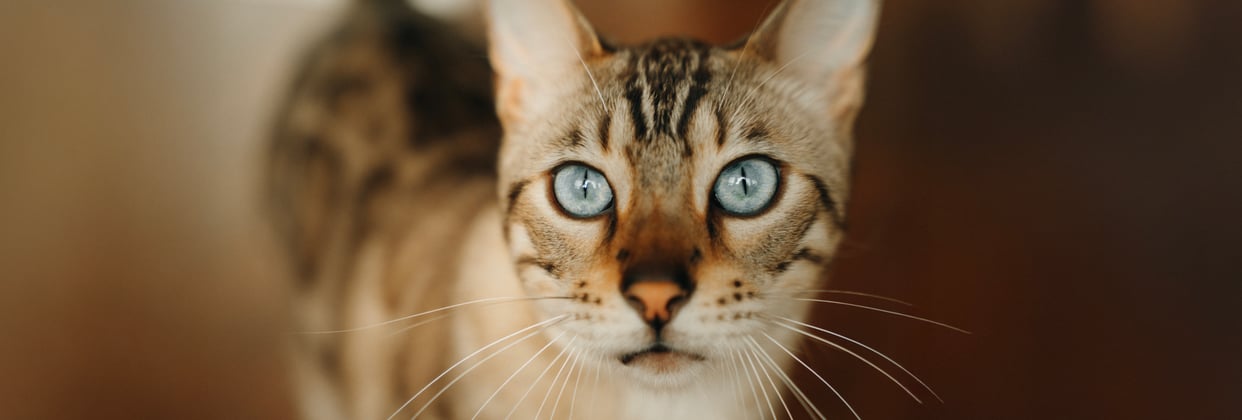

Living with a Bengal cat.
Bringing a Bengal cat home often requires a bit of prep. Because they’re an active breed, you’ll need toys, scratching posts, and interactive activities.
They thrive on human company. Bengals might follow you from room to room, meowing for attention or “helping” you with daily tasks. If you’ve been out for a while, be ready for a warm, chatty greeting.
Some owners wonder if Bengals can be an outdoor cat. While they might love the adventure, it’s often safer to keep them indoors or in a secure outdoor enclosure. Their confidence can lead to exploring dangerous areas.
If you want to see them truly happy, provide puzzle toys and climbing spots. They also like water. You may catch your Bengal dipping a paw into the sink or stepping into the shower.
Grooming and care.
Although they’re sometimes billed as a high-maintenance cat breed in terms of energy, they don’t usually require intense grooming. Here’s what to consider:
Brushing: A weekly routine can remove loose hair, though Bengals often groom themselves neatly.
Bathing: Some owners say their Bengals aren’t terrified of water. But baths aren’t needed frequently unless the coat is soiled.
Nail care: Trim claws when necessary. Provide scratching surfaces so they can wear down nails naturally.
Dental health: Brushing your cat’s teeth is useful. For guidance, you can read our ultimate guide to cat dental care.
By keeping things simple yet consistent, you ensure Bengals remain healthy cats that look and feel great.
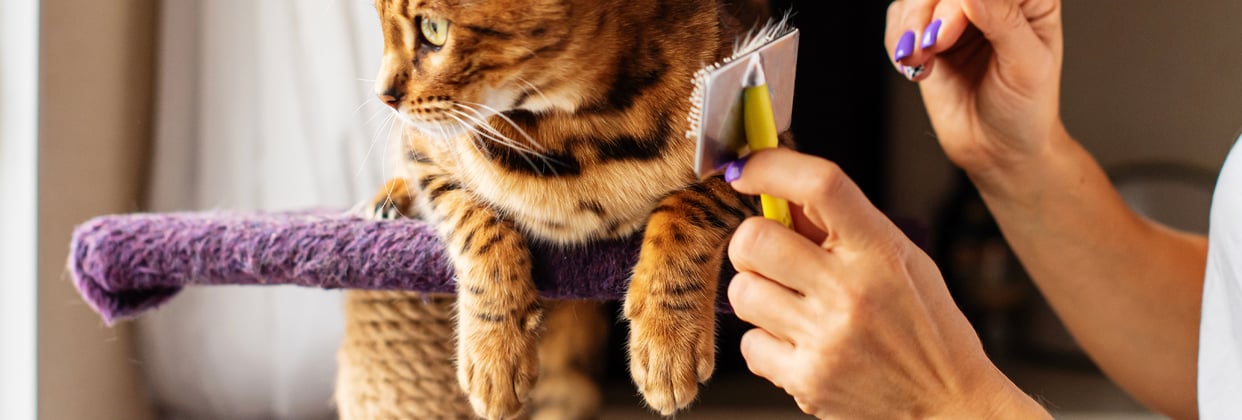

Diet and exercise.
A Bengal cat's diet is key to preserving their sleek figure and bright coat. Some owners choose top-tier brands, though any quality feed suited to the cat’s age and health can be fine. The key is to feed properly sized portions. Overfeeding can lead to weight gain, which can harm their overall health.
It is important to feed them a balance of protein and nutrients that matches their active lifestyle. If they get too many snacks or if you skip interactive play, they could become restless or overweight.
Aim for 30-60 minutes of stimulating activity daily. Use feather wands or other active toys.
Bengals can even learn to fetch! If you offer climbing frames or window perches, they’ll burn off energy naturally.
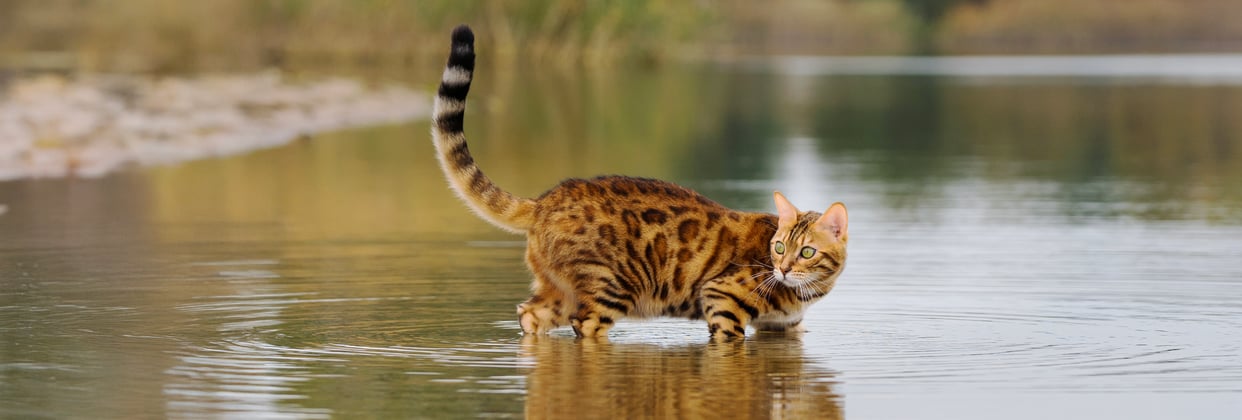

Is a Bengal cat right for you?
If you dream of a cat that’s playful, intelligent, and truly unique, a Bengal could be the perfect match.
They offer a striking look, with leopard-like spots or spotted or marbled patterns that dazzle visitors. Their mind is always curious, pushing them to explore every nook in your house.
However, think about your schedule. Bengals need to be groomed occasionally and exercised daily.
If you’re away from home for long periods, they might become bored. Some families consider having two Bengals or another feline companion to keep each other entertained.
We urge anyone looking for a Bengal breeder to do thorough research. Always look for accredited Bengal catteries that specialise in health screening. Ethical breeding leads to purebred Bengal kittens with fewer medical concerns.
When you ensure you buy your Bengal from an ethical breeder, you’re giving yourself and the cat the best chance at a long, happy life.
Also remember that certain rescue groups have Bengals available for adoption, which might be a lovely alternative if you want to offer a good home to a deserving pet cat.
Frequently asked questions.
Is a Bengal cat hypoallergenic?
No cat is fully allergy-free, but many find that the Bengal’s short fur and minimal shedding are easier on allergies than some other breeds. Still, calling them a true hypoallergenic cat can be misleading, as reactions differ per person.
How do I choose a Bengal kitten?
Start with accredited Bengal cat breeders who emphasise quality of the kitten. Meet the parents if possible and ensure they seem friendly and well cared for. You might also consider rescue groups that focus on Bengals.
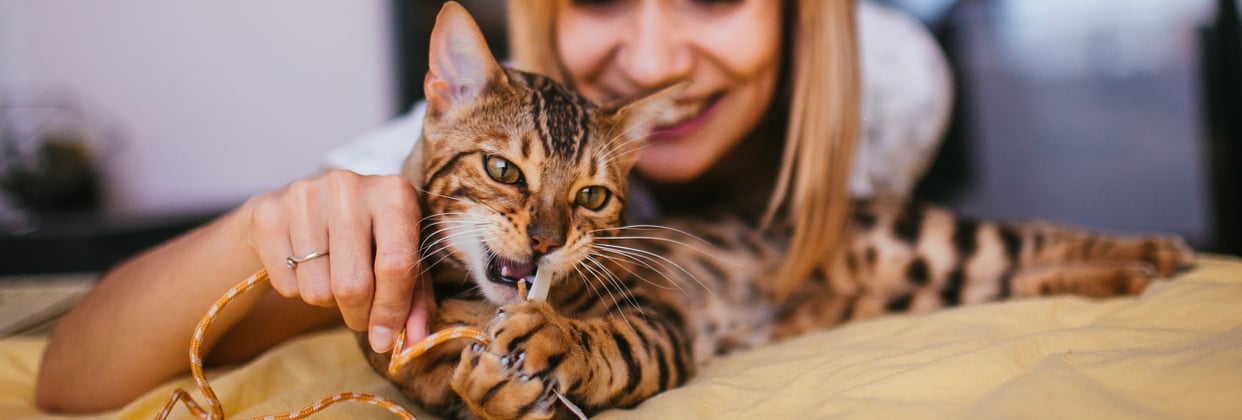

Are Bengals good family pets?
Yes. Though energetic, many Bengals fit well in households with children or other cats and kittens. They like human company and can become loyal companions. Just supervise small kids to ensure respectful pet handling.
What is the price of a Bengal cat?
The price of a Bengal cat varies. Some breeders charge anywhere from a few hundred to over a thousand pounds, depending on coat quality and lineage. Show-quality Bengals can be higher. Always verify the breeder’s reputation.
Do Bengals get along with dogs?
They often do, provided both animals are introduced carefully. Bengals are pretty confident, so a dog with a calm, friendly nature can become a good companion.
Do Bengal cats need outdoor access?
They don’t require it if you keep them active indoors. Many owners provide catios or safe outdoor enclosures. Bengals tend to roam if fully let outside, which can be risky.
Pet insurance for Bengals.
Life with a Bengal can be exciting and heartwarming. From their vibrant coat patterns to their unstoppable curiosity, these intelligent cats bring a spark to each day.
If you’re ready for an active and intelligent companion with wild ancestors, the Bengal breed will not disappoint. Just remember to focus your attention on ethical breeding, consistent care, and mental enrichment.
By doing so, you’ll share your home with a beautiful cat that thrives on adventure, all while building a special bond for years to come.
